In a previous article, "Interval Riff Basics", we looked at and heard examples of using only two notes, or intervals, for rhythm guitar parts. The two main intervals are fifth and thirds, with the latter adding more variety and color to your riffs. Now we'll look at ornamenting these two basic sounds with melody fragments. Doing so also introduces other intervals, including seconds, fourths and sixths, but each will be subservient to our core intervals of the third and fifth... at least for now.
There are two types of notes in music: chord tones and non-chord tones. Our ornamentation will be done with non-chord tones, specifically the one called a "neighbor tone". A neighbor tone is next to a current chord tone, and is approached and left in opposite directions. For example, if holding an E minor third (the notes E and G), and the upper note, G, drop down to F#, and then back up to G, the F# is a neighbor tone. See Example 1a.
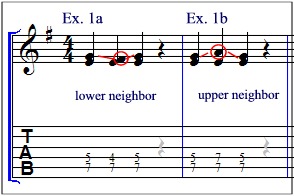
In this case, the F# is a lower neighbor. There is also an upper neighbor, which would be A. See Example 1b. Listen to this example of thirds ornamented with lower neighbor tones. Within the example are major thirds, a minor third, and major seconds, as shown in Example 2.
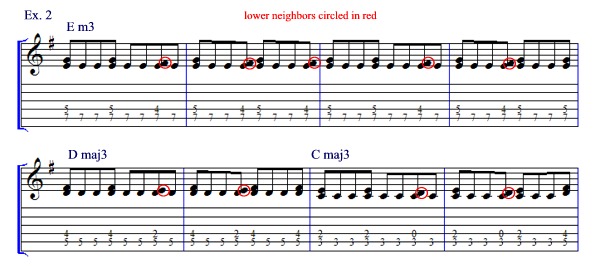
Notice how there is a constant eighth-note pulse on the 5th string throughout this example, and that an interval of one kind or another is only sounded at certain accents, when both notes are sounded. At that moment, the muting from the right hand is lifted so the chord can be heard. This brief moment is one reason the relatively dissonant interval of a major second (E and F#) works. If you were to sound the major second and let it ring longer, it sounds much more dissonant.
Example 3 and its accompanying mp3 use both lower and upper neighbors to create a more active line. Of special note is the last measure, where an F# was used because it is in the key. With the C below it, it creates an augmented fourth, which usually sounds like it should resolve upward by step to the fifth, which is the case here. The F# is also a passing tone, not a neighbor tone, and such a motion is discussed below.
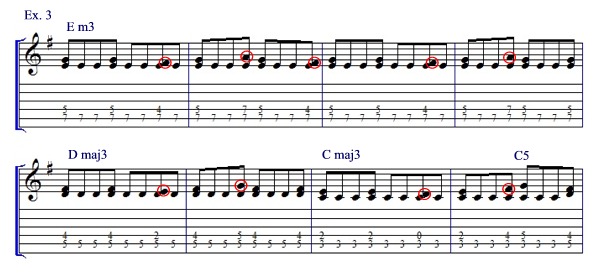
Just like thirds, fifths have both a lower and upper neighbor. The lower neighbor is usually a perfect fourth, while the upper one can be either a minor or major sixth, depending on where you are in the key. See Example 4.
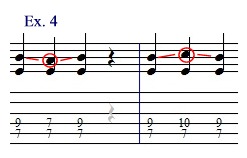
In most of Example 5, the perfect fourth is used, but listen again for the augmented fourth (the F#) above the C, as expected by the key of E minor. It is possible to use the perfect fourth above C and introduce an F natural.
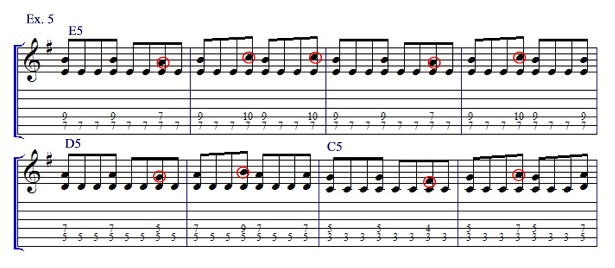
To connect a third with a fifth above the same root, such as E, another kind of non-chord tone is used: the passing tone; in this case, a fourth. A passing tone is approached and left in the same direction. For example, with E on the bottom continuously, G can pass through A on its way to B, moving from the interval of a minor third, through a fourth, to a fifth. The opposite direction works equally well. See Example 6.

Of course, it's not necessary to connect the third and fifth at all. You can simply alternate.
This final mp3 illustrates a riff connecting thirds and fifths as in Example 7.

Adding ornamentation is a good way to introduce melody to your rhythm guitar parts, but we've only scratched the surface of what can be done. In a future article, we'll explore counterpoint and see how to write two different lines for one guitarist to play alone.
Randy Ellefson is an instrumental guitarist with endorsements from Alvarez Guitars, Peavey, and Morley Pedals, and a Bachelors of Music in classical guitar, Magna Cum Laude.
His most recent album, "Some Things Are Better Left Unsaid", was independently released in July 2007. Ellefson is also known for his extensive experience with tendonitis, which once took away his playing for five years.